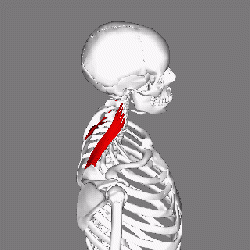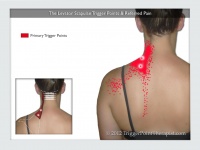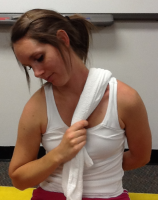Levator Scapulae Syndrome: Difference between revisions
No edit summary |
Rachael Lowe (talk | contribs) No edit summary |
||
| Line 1: | Line 1: | ||
<div class="editorbox">
'''Original Editor ''' [[User:Andeela Hafeez|Andeela Hafeez]] '''Top Contributors''' - {{Special:Contributors/{{FULLPAGENAME}}}} | <div class="editorbox">
'''Original Editor ''' [[User:Andeela Hafeez|Andeela Hafeez]] | ||
'''Top Contributors''' - {{Special:Contributors/{{FULLPAGENAME}}}} | |||
</div> | |||
== Introduction == | |||
= | [[Levator Scapulae Syndrome|Levator Scapulae Syndrome]] is an historical name for "pain over the upper medial angle of the scapula"<ref name="Menachem">Menachem A1, Kaplan O, Dekel S. Levator scapulae syndrome: an anatomic-clinical study. Bull Hosp Jt Dis. 1993 Spring;53(1):21-4.</ref> that is still used in clinical practice in some places around the world. This terminology (and use of the word syndrome) describes is a set of signs and symptoms that often present together without identifying the cause of the pain and dysfunction i.e chronic fatigue syndrome, irritable bowel syndrome. These days we prefer to use our clinical reasoning skills to identify possible causative factors that we can address during treatment. | ||
== Clinically Relevant Anatomy == | |||
[[Image:Levator scapulae muscle animation small2.gif|right|250x250px]] | |||
The [[Levator Scapulae|levator scapulae]] muscle extends from C1-4 to the medial aspect of the scapula, between the superior angle and the root of the spine. It's function is to assist with various neck, arm and shoulder movements such as shoulder elevation and cervical side flexion. | |||
== Description == | |||
Often this muscle can become tense and painful leading to reduced motion in the area. The dominant shoulder is most commonly involved (82%) and pain radiated to the neck and shoulder, but rarely to the arm<ref name="Menachem" />. | |||
== Causes == | |||
* | *Cervical spine dysfunction. | ||
*Altered shoulder biomechanics or poor posture. | |||
*Repetitive arm motions such as in swimming, throwing, or racquet sports. | |||
*Carrying bags with straps over the shoulder. | |||
*In anxiety many people who experience the effects of these trigger points also complain of a shortness of breathe like that associated with panic attacks. <br> | |||
* | == Sign and Symptoms == | ||
*Neck pain, which may extend to the head causing a headache. | |||
*Pain and restricted range of movement, especially reduced cervical flexion and side flexion to the contralateral side. | |||
*Deep, achy pain and/or tightness on the upper back along the top of the shoulder blade or neck.<br> | |||
*Increased muscle tone and trigger points. | |||
[[Image:Levator scapula trigger points referred pain.jpg|right|200px]] | |||
=== Trigger points === | === Trigger points === | ||
The Levator Scapulae can | The Levator Scapulae can present with two trigger points located in the lower half of the muscle. The lower trigger point lies just above the superior angle of the scapula and upper trigger point lies 1-3 inches above the lower trigger point. Both trigger points lie deep to the upper trapezius muscle. Both trigger points refer pain laterally to the shoulder and along the medial aspect of the shoulder blade. | ||
= | == Examination == | ||
<span style="background-color: initial;">With this presentation of pain and trigger points in the levator scapulae it is important to complete a full [[Cervical_Examination|assessment of the cervical spine]] as pain in this region is often referred from the cervical spine.</span> | |||
=== | <span style="background-color: initial;" /><span style="font-size: 13.28px; line-height: 19.92px;">You must also rule out the thoracic spine and shoulder. </span>The phenomenon of levator scapulae pain of cervical origin being reproduced on shoulder movement has long been clinically recognised<ref name="Behrsin ">Behrsin JF and Maguire K. Levator Scapulae Action during Shoulder Movement: A Possible Mechanism for Shoulder Pain of Cervical Origin. Australian Journal of Physiotherapy, 1986, 32(2):101–106</ref>. | ||
<span style="background-color: initial;" /><span style="font-size: 17.5296px; font-weight: bold; line-height: 1.5em; background-color: initial;">Flexibility Test</span> | |||
Movements that stretched the levator scapulae on the affected side aggravated symptoms.<br> | |||
=== Palpation<br> === | |||
= Treatment = | = Treatment = | ||
| Line 49: | Line 55: | ||
=== Electrotherapy === | === Electrotherapy === | ||
Medium frequency appears to be most effective, but any current which can tire and sedate the muscle is effective. This is done to relax the muscle and soften | Medium frequency appears to be most effective, but any current which can tire and sedate the muscle is effective. This is done to relax the muscle and soften fibres.<br>Pulsed ultrasound (0.8 to 1.8 w/cm2) using Ibuprofen ointment, or other sedative and anti-inflammatory gel. | ||
=== Rehabilitation === | === Rehabilitation === | ||
As long as there are no complications and you rest appropriately, the injury should soon begin to clear up. When you are pain free, you will be able to commence physical therapy with the doctor's approval. This stage is important for gradually replacing the lost strength in the neck and building up flexibility in the area before attempting to return to activity.Levator Scapulae Syndrome responds very well Active Release Techniques (ART), which is very effective in breaking up the scar tissue adhesion formation in Levator Scapulae and surrounding muscles, allowing the muscles to stretch and contract normally again (keep in mind it is these scar tissue adhesion that are causing the muscle to be tight and restricted in the first place). | As long as there are no complications and you rest appropriately, the injury should soon begin to clear up. When you are pain free, you will be able to commence physical therapy with the doctor's approval. This stage is important for gradually replacing the lost strength in the neck and building up flexibility in the area before attempting to return to activity. Levator Scapulae Syndrome responds very well Active Release Techniques (ART), which is very effective in breaking up the scar tissue adhesion formation in Levator Scapulae and surrounding muscles, allowing the muscles to stretch and contract normally again (keep in mind it is these scar tissue adhesion that are causing the muscle to be tight and restricted in the first place). | ||
Stretching exercises<br> [[Image:Levator stretch.png|200x200px]]<br> | Stretching exercises<br> [[Image:Levator stretch.png|200x200px]]<br> | ||
Strengthening exercises | |||
It is also important that biomechanical problems that may be contributing to the condition, such as neck or shoulder muscles imbalances, postural problems, or upper back mobility are identified and corrected as these are usually the causes of increased stress on the Levator Scapulae in the first place. addressing these mechanical problems provides a long term solution of the problem and | It is also important that biomechanical problems that may be contributing to the condition, such as neck or shoulder muscles imbalances, postural problems, or upper back mobility are identified and corrected as these are usually the causes of increased stress on the Levator Scapulae in the first place. addressing these mechanical problems provides a long term solution of the problem and minimise the chances of reoccurrence<br> | ||
== Recent Related Research (from [http://www.ncbi.nlm.nih.gov/pubmed/ Pubmed]) == | == Recent Related Research (from [http://www.ncbi.nlm.nih.gov/pubmed/ Pubmed]) == | ||
<div class="researchbox">
<rss>http://www.ncbi.nlm.nih.gov/entrez/eutils/erss.cgi?rss_guid=1tuP1jHjERTRY3G_aVPDc6x_i7YB3SwDw-X1JOoEOlWmcArM4m !!|charset=UTF8|short|max=10</rss>
</div> | <div class="researchbox">
<rss>http://www.ncbi.nlm.nih.gov/entrez/eutils/erss.cgi?rss_guid=1tuP1jHjERTRY3G_aVPDc6x_i7YB3SwDw-X1JOoEOlWmcArM4m !!|charset=UTF8|short|max=10</rss>
</div> | ||
= References = | = References = | ||
<references /> | <references /> | ||
[[Category:Musculoskeletal/Orthopaedics|Orthopaedics]] [[Category:Muscles]] | |||
[[Category:Musculoskeletal/Orthopaedics|Orthopaedics]][[Category:Muscles]] | |||
Revision as of 16:25, 18 January 2016
Top Contributors - Andeela Hafeez, Rachael Lowe, Tony Lowe, Kim Jackson, Alexander De Bock, WikiSysop, Eugenie Lamprecht, Robin Meynendonckx, Shwe Shwe U Marma, 127.0.0.1, Kishan Muthukuda and Evan Thomas
Introduction [edit | edit source]
Levator Scapulae Syndrome is an historical name for "pain over the upper medial angle of the scapula"[1] that is still used in clinical practice in some places around the world. This terminology (and use of the word syndrome) describes is a set of signs and symptoms that often present together without identifying the cause of the pain and dysfunction i.e chronic fatigue syndrome, irritable bowel syndrome. These days we prefer to use our clinical reasoning skills to identify possible causative factors that we can address during treatment.
Clinically Relevant Anatomy[edit | edit source]
The levator scapulae muscle extends from C1-4 to the medial aspect of the scapula, between the superior angle and the root of the spine. It's function is to assist with various neck, arm and shoulder movements such as shoulder elevation and cervical side flexion.
Description[edit | edit source]
Often this muscle can become tense and painful leading to reduced motion in the area. The dominant shoulder is most commonly involved (82%) and pain radiated to the neck and shoulder, but rarely to the arm[1].
Causes[edit | edit source]
- Cervical spine dysfunction.
- Altered shoulder biomechanics or poor posture.
- Repetitive arm motions such as in swimming, throwing, or racquet sports.
- Carrying bags with straps over the shoulder.
- In anxiety many people who experience the effects of these trigger points also complain of a shortness of breathe like that associated with panic attacks.
Sign and Symptoms[edit | edit source]
- Neck pain, which may extend to the head causing a headache.
- Pain and restricted range of movement, especially reduced cervical flexion and side flexion to the contralateral side.
- Deep, achy pain and/or tightness on the upper back along the top of the shoulder blade or neck.
- Increased muscle tone and trigger points.
Trigger points[edit | edit source]
The Levator Scapulae can present with two trigger points located in the lower half of the muscle. The lower trigger point lies just above the superior angle of the scapula and upper trigger point lies 1-3 inches above the lower trigger point. Both trigger points lie deep to the upper trapezius muscle. Both trigger points refer pain laterally to the shoulder and along the medial aspect of the shoulder blade.
Examination[edit | edit source]
With this presentation of pain and trigger points in the levator scapulae it is important to complete a full assessment of the cervical spine as pain in this region is often referred from the cervical spine.
You must also rule out the thoracic spine and shoulder. The phenomenon of levator scapulae pain of cervical origin being reproduced on shoulder movement has long been clinically recognised[2].
Flexibility Test
Movements that stretched the levator scapulae on the affected side aggravated symptoms.
Palpation
[edit | edit source]
Treatment[edit | edit source]
In general, levator scapulae syndrome can often be treated conservatively, first by ceasing any physical activity that could exacerbate the condition and taking rest until the symptoms have diminished.
Limiting arm and shoulder movements can be beneficial. Cite error: Invalid <ref> tag; name cannot be a simple integer. Use a descriptive title
Anti-inflammatory pain medication can help to reduce aching and any swelling,
while icing the area approximately 3 times per day can provide non-medicinal relief.Cite error: Invalid <ref> tag; name cannot be a simple integer. Use a descriptive title
Electrotherapy[edit | edit source]
Medium frequency appears to be most effective, but any current which can tire and sedate the muscle is effective. This is done to relax the muscle and soften fibres.
Pulsed ultrasound (0.8 to 1.8 w/cm2) using Ibuprofen ointment, or other sedative and anti-inflammatory gel.
Rehabilitation[edit | edit source]
As long as there are no complications and you rest appropriately, the injury should soon begin to clear up. When you are pain free, you will be able to commence physical therapy with the doctor's approval. This stage is important for gradually replacing the lost strength in the neck and building up flexibility in the area before attempting to return to activity. Levator Scapulae Syndrome responds very well Active Release Techniques (ART), which is very effective in breaking up the scar tissue adhesion formation in Levator Scapulae and surrounding muscles, allowing the muscles to stretch and contract normally again (keep in mind it is these scar tissue adhesion that are causing the muscle to be tight and restricted in the first place).
Strengthening exercises
It is also important that biomechanical problems that may be contributing to the condition, such as neck or shoulder muscles imbalances, postural problems, or upper back mobility are identified and corrected as these are usually the causes of increased stress on the Levator Scapulae in the first place. addressing these mechanical problems provides a long term solution of the problem and minimise the chances of reoccurrence
Recent Related Research (from Pubmed)[edit | edit source]
References[edit | edit source]
- ↑ 1.0 1.1 Menachem A1, Kaplan O, Dekel S. Levator scapulae syndrome: an anatomic-clinical study. Bull Hosp Jt Dis. 1993 Spring;53(1):21-4.
- ↑ Behrsin JF and Maguire K. Levator Scapulae Action during Shoulder Movement: A Possible Mechanism for Shoulder Pain of Cervical Origin. Australian Journal of Physiotherapy, 1986, 32(2):101–106









